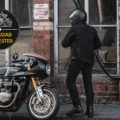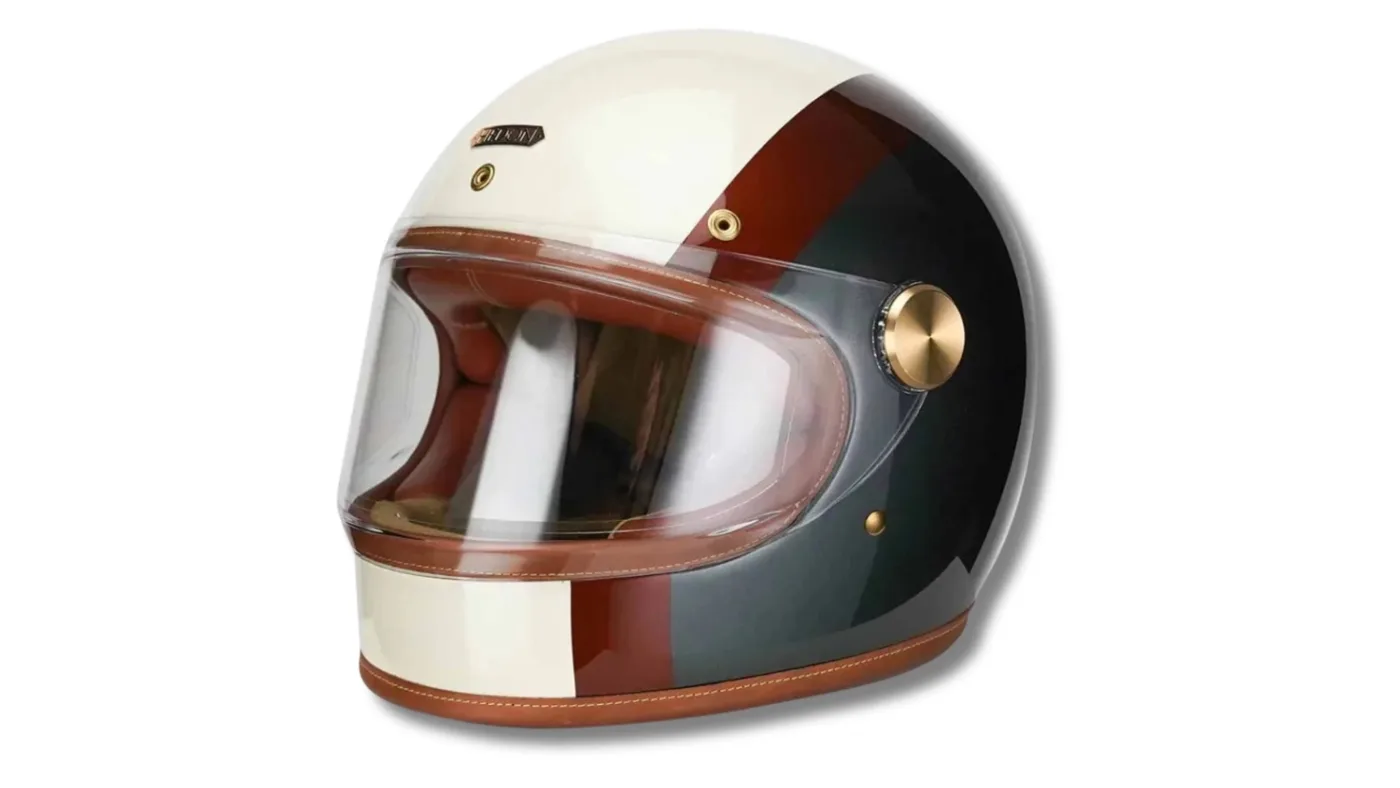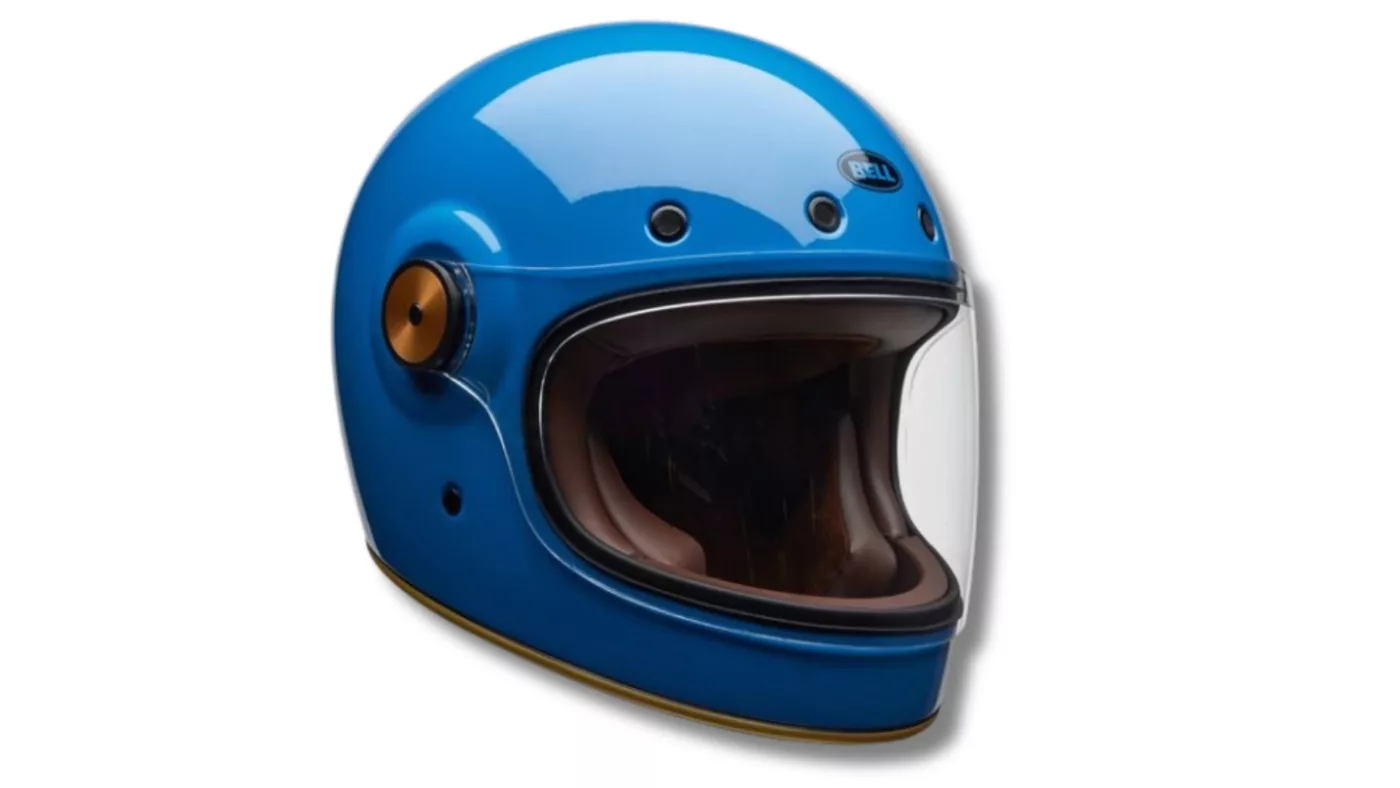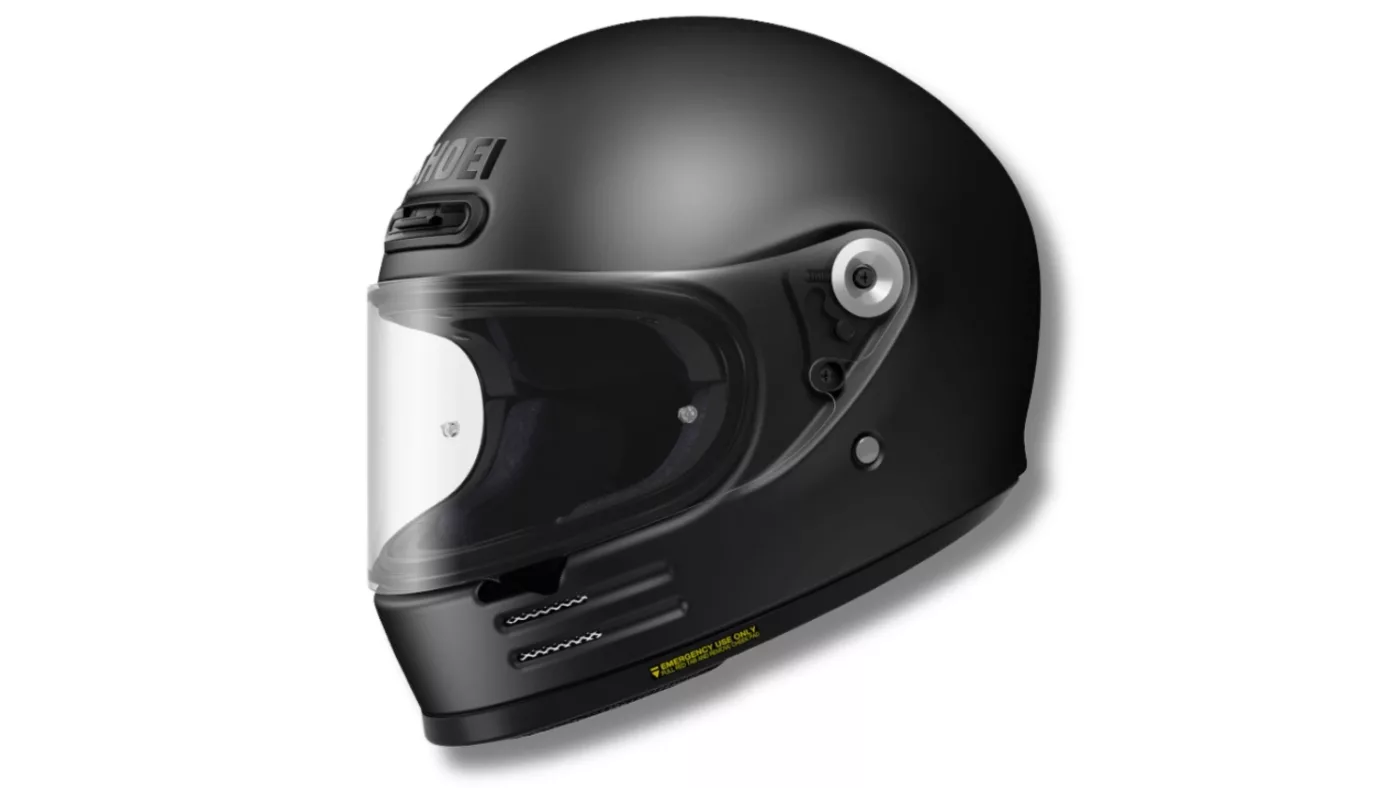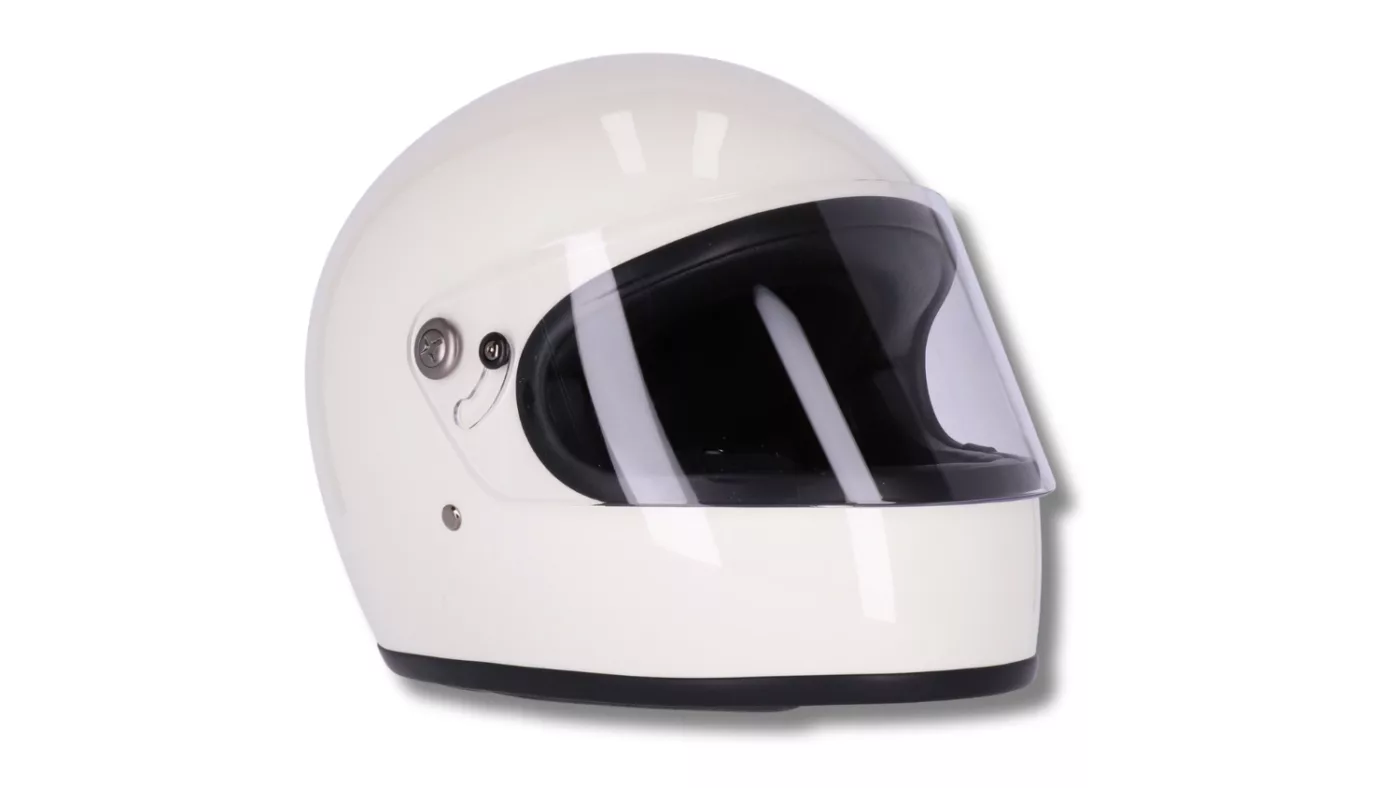A little over a decade ago, buying retro motorcycle helmets conforming to modern safety standards was challenging. Nowadays, the opposite is true. Numerous helmets, combining vintage looks with contemporary protection, are available to buy, with options to suit all budgets.
Riders of café racers and modern classic motorcycles seeking vintage motorcycle helmets have an overwhelming choice. Cutting through the noise, we’ve created this list of the best full face retro helmets you can buy in 2025.
Best Retro Motorcycle Helmets 2025

Emergence of Retro Helmets
Wearing a modern helmet on a classic or retro bike is jarringly anachronistic – or more simply, it can make you look like a plonker.
Just over a decade ago, you had little choice: either clash with your bike’s aesthetics or compromise protection. The vintage motorcycle helmet in its modern incarnation was non-existent.
Back then, only non-road-legal nostalgia lids or bona fide vintage brain buckets were available. All that changed in 2015 with the launch of the original Bell Bullitt.

1. Bell Bullit GT

It’s only right that this review list kicks off with the updated version of the café racer crash lid that defined the vintage-style helmet segment.
Inspired by a 2011 design concept by Chad Hodge (based on the ’60s and ‘70s Bell Star), the Bell Bullitt launched in 2013 to a rapturous response. Since then, it’s encouraged new boutique brands and other major manufacturers to launch their own offerings inspired by the past, some of which you’ll see further down this list.
The new Bullitt GT still features an ultra-low-profile chin guard, fully embracing seventies aesthetics while offering an exceptional space-helmet-like field of vision. In the updated version, the chin guard is slightly larger and farther away from the rider’s chin.
The GT’s removable multi-density EPS cheek pads and liners are available in numerous sizes (featuring speaker cutouts) and work with glasses too. They’re washable too, meaning sweat and grim build-up are not an issue for very long… depending on how often you wash them, of course.
There are eight Bullitt GT colourways available in the fibreglass version and four in the carbon fibre variant. The latter is super lightweight, weighing just 1.35kg for the M size (give or take 50 g depending on size).
You’ll need to spend over£600 / $650 / €700 for the carbon versions. However, there are many deals to be had on the 22.05 version since the launch of the ECE 22.06 GT.
The Bullitt is well-ventilated with four mesh porthole vents at the front, which are now closable with a switch located under the right side of the chin bar, meaning riders can now fine-tune airflow. However, the rectangular mesh vent in the chin bar is gone.
With all the accessories tallied, there’s a Bullitt GT for all tastes. Nonetheless, bona fide café racer riders and retronauts will love this lid even more when paired with the bubble shield visor, particularly appealing. If, however, the Bullitt is beyond your budget, several Bell Bullitt alternatives or copycats are available at a lower price. They do very little to hide their inspiration and they’re comparable in features to the Bullitt.
- Head Shape: Round Oval
- Certification: DOT & ECE 22.06
- Shell Sizes: 3 Shell and EPS Sizes – XS, S, M, L, XL & XXL
- Weight: (Size M) 1.35kg ±50g [fibreglass] or 1.45kg (±50g [carbon fibre]
2. Hedon Heroine Racer 2.0

A favourite of the DGR crowd is the rather more decadent Hedon Heroine Racer, which first came to prominence in 2017. The Heroine is very much at the premium end of the segment.
A standard version is nearly twice the cost of the Bell. However, it’s also much quieter than the Bullitt. Regardless, this is an apples and pears comparison.
Each Hedon Heroine Racer is handcrafted from a composite fibre shell composed of fibreglass and carbon fibre. As such, it’s a lightweight lid. It’s also fashioned with a low-profile silhouette, synonymous with Hedon design, with a plush padded interior replete with recesses for Bluetooth speakers.
The Racer suffix is the clue to the inspiration behind its classic racing design. Though equally, the broad chin guard doesn’t hide the late ’70s influence. The Heroine Racer is exquisitely finished with leather trim and anodised brass found on the nameplate, double D ring and the broad visor screws on either side of the helmet.
Incidentally, the CNC visor screws have been given an upgrade, making them lighter. But pertinently, it means the visor now has four lock positions instead of the two found on the MK1. The new screws also address the previously slightly finicky process of swapping out the visor.
Aside from the option to purchase and then combine different visors and hardware, Hedon offers a customisation service. That means seemingly infinite possibilities to create a unique design.
- Head Shape: Intermediate Oval
- Certification: ECE 22.06 and DOT FMVSS
- Shell Sizes: x3 – S/M, L/XL and XXL/XXXL
- Weight: 1.2 kg to 1.39 kg +/-50 kg depending on shell size
3. Biltwell Gringo S ECE 06

Only two ventilation holes might be insufficient in hot weather.
For several years, the Biltwell Gringo S helmet was road legal only in North America. Modern classic and custom riders in Europe looked on with envy. Not just because of its attractive vintage-inspired proportions, but also its highly attractive price point.
In 2018, however, Biltwell bit the bullet and upgraded to meet ECE 22.05 certification.
Combined with the injection-moulded ABS outer shell, the Gringo S received thicker EPS shock-absorbing foam in the chin bar. In January 2024, Biltwell subsequently upgraded to the latest ECE standard, 22.06 and with it came cool new colourways.
The Gringo’s inner EPS shell was also reworked for greater impact absorption. All of that makes it suitable for the UK, European and Australian markets.
Ventilation is limited to two holes in the Gringo S, so it’s not the best for staying cool on extra hot days. However, the discreet, easy snap mechanism on the left side makes cracking the visor open for cooler air easy.
The Gringo is more rugged than the Bell and Hedon. Nonetheless, the diamond-stitched (by hand) padded Lycra interior offers some air of refinement and definitely comfort. Furthermore, it’s removable for easy washing.
Notably, Biltwell visors (from December 2022 onwards) feature PINLOCK® and ProtecTINT™, which guard against fogging and glare, respectively.
The Gringo S, ECE 06 is available in two lightweight shell sizes covering XS-MD and LG-2XL, respectively. It suits riders who prefer a rounder fit as opposed to an oval. Equally, riders who favour customs over modern classics are likely to prefer this lid. It just seems to align more closely with the built-not-bought ethos, echoing Biltwell’s starting point in aftermarket parts.
- Head Shape: Round Oval
- Certification: DOT FMVSS & ECE 22.06
- Shell Sizes: x6 shell from XS to XXL
- Weight: ~ 1.3kg to 1.5 kg
4. Shoei Glamster 06

Never has there been a greater travesty in product naming than Shoei Glamster. Clearly, that’s hyperbole. Still, it’s not a great name that belies an otherwise excellently styled café racer lid with superb safety features.
I suppose when a helmet looks this good, it can call itself anything it wants (also hyperbole).
Regardless, this neo-classic lid has it all, combining an early seventies-like outline with all the modern features you’d expect to find on contemporary-styled counterparts, minus all the fins and spoilers.
Those features include an E.Q.R.S. (Emergency Quick Release System), an EPS liner with removable cheek pads and a UV-protected visor that’s compatible with Pinlock EVO fog-resistant inserts. All of that is packaged into Shoei’s lauded AIM shell. For this model, there are three shell sizes to help fine-tune the fit.
There is also plenty of ventilation to be found throughout, with additional grooves built into the inner lining to channel cooling.
Sharp (the Department for Transport’s motorcycle helmet testing unit) awarded the original version of this brain bucket 4 out of 5 stars in its impact tests. However, Shoei, in March 2023, released an updated version to meet and exceed the latest EU standard, ECE R22-06. It’s likely the Glamster 06 will achieve a similar rating, if not higher.
The Shoei Glamster 06 is for neo-retro riders and those who want super-modern safety features while paying homage to the past.
- Head Shape: Intermediate Oval
- Certification: ECE 22-06
- Shell Sizes: x3 – (XS-M/ L/ XL-XXL)
- Weight: 1.2 kg to 1.39 kg +/-50 kg depending on shell size
5. John Doe – JD/ONE Helmet

The JD/One Helmet was released in August 2024 and is John Doe’s first foray into helmet manufacture. It’s an impressive-looking seventies-style lid with a retro-futuristic aesthetic that could make it the offspring of the Shoei Glamster and Hedon Heroine.
With its striking proportions, it (unsurprisingly) received an exceptionally positive reception on release. However, the most intriguing feature of this helmet is the ‘Multi-lock’ innovation that allows you to customise the look and function of the helmet.
Riders can transform it from a full-face to a vintage-style MX helmet, to be worn with goggles, by swapping out face shields for short peak visors. Along with hinge plates and screws, remarkably, there are more than 1,305 potential combinations.
Aside from all its chameleon-like abilities, the JD/One stands out in the retro segment with several features typically found on contemporary-looking helmets
Like Arai and Shoei’s offerings, the One helmet is equipped with an EQRS allowing for easy emergency removal of its glasses-friendly, multi-part EPS lining, which is replete with speaker cuts.
Protection-wise, it meets both ECE 22.06 (EU) and DOT (US) standards with a lightweight fibreglass-reinforced plastic (FRP) with a carbon composite shell variant – both available in four sizes, meaning greater diversity of fit.
Most riders are happy with the ventilation found at the centre of the brow and temples, removed via rear exhaust vents. Feedback on wind noise is good – likely assisted by the tight seal, somewhat mitigating the effect of the large opening at the base helmet. It also boasts a wide field of vision like the Bullitt, making it highly suitable for commuting.
With nine colourways available, at an almost unbelievably starting price point (£255 / $346 / €359 for the standard version and £338 / $462 / €479.90 for the carbon variant), the JD/One offers exceptional value for money. It makes it hard to ignore – even in a field as venerable as this.
- Head Shape: Round Oval
- Certification: ECE 22.06 and DOT FMVSS No. 218
- Shell Sizes: 4 Shell and Multi-Density EPS – XS-S, M, L and XXL
- Weight: 1.45 kg +-50 (grams depending on shell size)
6. DMD Rivale

DMD has built a solid reputation among custom and modern-classic riders through the design of its low-profile lids, particularly the Rocket and the Vintage. Both offer classic style, comfort and protection in a multitude of hues and colourways and they do it at reasonable price points.
However, the DMD Rivale (which is the brand’s newest full-face offering) is found slightly further upstream at a price point north of £359.
Nineteen-seventies motosport is where DMD’s latest head PPE gets its inspiration.
Visually, the tri-composite shell (composed of carbon, fibreglass and Kevlar) is somewhere between the Hedon Heroine and Shoei Glamster, although closer to the latter. Undoubtedly, there will be comparisons between the two due to their visual similarities.
Currently, the Rivale is available in two shells: XS-M and L-XL. There’s a noticeable difference in sizing between the two shells when placed side by side. However, generally, the minimalist aesthetic means the larger Rivale is still comparatively low-profile, although it’s larger than the DMD Rocket.
Two, always-open horizontal vent ports placed on either side of the chin bar form the basis of ventilation. At the time of writing, this helmet is new. As such, there’s not a lot of feedback on how effective it is at keeping its interior temperature low.
A smoked visor can be purchased for under £60 to replace the standard pin-closed clear visor that comes in the box.
In typical DMD style, the Rivale is supplied with a comfortable removal and washable interior. It’s available in several graphic-based colourways and solid colours that will appeal to riders who dig seventies moto style.
- Head Shape: Intermediate Oval
- Certification: ECE 22.06
- Shell Sizes: Two Shells – XS-M, L-XL
- Weight: ~1.2 kg
7. Arai Concept XE (R22-06)

Launched slightly before Shoei’s full-face modern-classic offering, the Arai Concept XE takes a similar tack to its main rival, the Shoei Glamster 06. So, this helmet is full of the same technology you’d expect to find in the brand’s contemporary-styled range. And yet it’s packed into a sleek neo-classic shell with ERS- updated for 2023 to conform to ECE R22-06.
Within the Concept XE, you’ll find the same Special Fibre Laminate shell, which absorbs and dissipates impact energy across the whole dome.
We think the Concept XE’s old-school looks are more subtle than other helmets on this list, though more apparent from certain angles, particularly the squared-off front grill. To place this lid in time, you’ll only have to travel back to the eighties.
The Concept XE’s designers have perfectly captured the retro-futuristic aesthetic of the eighties, yet combined it with robust technology.
Ventilation is found in the closable chin vents in the Concept XE’s plastic mesh-like structure at the front. That, combined with the brow-level intake and rear exhaust vent, helps control air circulation. As such, you can readily regulate the interior temperature.
The Concept XE may lose out to the Shoei in looks, depending on your viewpoint. However, it can certainly match the Glamster in its array of features.
This is one for riders with a penchant for eighties-style bikes… or maybe an XSR900 in the garage.
- Head Shape: Intermediate Oval
- Certification: ECE R22.06 for the 2023 version
- Shell Sizes: x3 shell sizes – XS-XL
- Weight: ~1.5 kg
8. Roeg Chase Helmet

If you’re looking for a simple, unadulterated classic helmet with minimal branding, the Roeg Chase is it. With an entry-level price point, it bucks the stereotype that all vintage-inspired motorcycle helmets are expensive. It does that with perfect old-school cool.
Roeg is a fairly no-nonsense brand, so it follows that the Chase is spartan in design, reminiscent of late seventies and early-eighties racing lids.
Its two shell sizes are composed of an RQ light fibreglass material entirely free of adornments, including ventilation holes and branding. As such, you’ll be hard-pressed to find a cleaner, smoother-looking lid that meets European and North American safety standards.
Nonetheless, the lack of vents means only an open visor will introduce airflow into the interior. Speaking of which, the lining is constructed from a multi-density EPS foam that offers a comfortable fit and dynamically absorbs impact. The micro-fleece liner that covers the interior is also removable and washable.
Continuing the theme of minimalism, an understated ROEG logo is discreetly placed on the lower rear lip. That’s something that many riders appreciate. Few wish to be walking adverts or, more accurately, riding adverts.
Just like the Chase’s design, Roeg has kept the colour options simple: JD Green, Vintage White, Gloss Black and Matte Black.
Riders considering the Gringo S on looks alone will likely find the Chase appealing and vice versa.
- Head Shape: Intermediate Oval
- Certification: ECE-R 22.05 & DOT
- Shell Sizes: x2 Shells – XS-M & L-XXL
- Weight: ~1.4 kg
Editor’s Picks: Best Retro Motorcycle Helmets 2025

Before we get to the full reto helmet list, I thought I’d briefly share some insight and my personal picks or Editor’s Picks, if you prefer.
I own the Hedon Heroine Racer 1.0 and the Bell Bullitt RSD Carbon. I’ve ridden about 20,000 miles in the Heroine and 18,000 miles in the Bullitt – a mix of town and countryside riding. The are both great-looking helmets and I love them for many reasons.
Among the reasons, the Bell Bullitt keeps me cooler on warm days and the field of vision is excellent. However, the plushness and comfort of the Hedon are unsurpassed in the retro helmet segment. Plus, it’s quieter than the Bullitt. (The new Bullitt GT design has attempted to remedy the noisy nature of the original.)

My love for both these helmets aside, riders purchasing a retro helmet today are spoilt for choice. Among the options I’d consider are the Shoei Glamster 06 and Roeg Chase – not to forget the relatively new John Doe One helmet, which cannot be ignored for its innovative nature.
Editor’s Retro Helmet Picks:
Wrapping Up & Further Reading

So there you have it, the eight best old-school helmets. Any of the helmets featured on this list will look great on your dome on a variety of modern-classic café racers or vintage and custom motorcycles – and importantly, protect you.
There isn’t any excuse to have vintage style without contemporary protection!

1. We’ve discussed aesthetics a lot in this article; nevertheless, safety, fit and comfort should be your primary considerations when buying any motorcycle helmet, retro or otherwise. And, with that in mind, be sure to read our guide on things to consider when you’re buying head PPE.

2. If you like the curves of the Bell Bullitt featured on this list but the price point of the Roeg Chase, then these similar budget-friendly lookalikes may be right up your street.
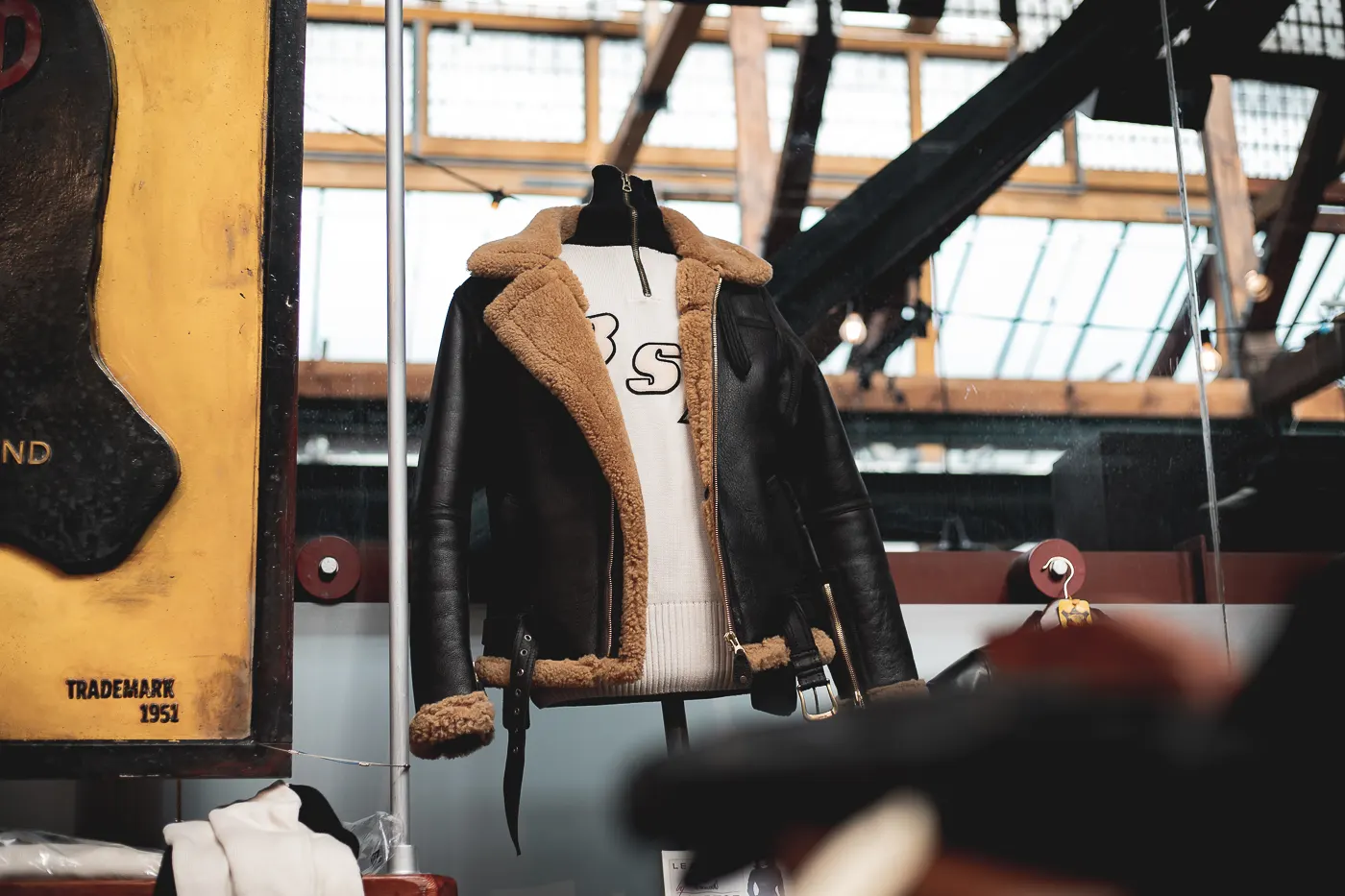
3. If you dig retro gear and protection in equally quantities, be sure to check out our guide highlighting purveyors of motorcycle gear inspired by yesteryear.
Quick Retro Helmet FAQs
Are Retro Helmets Good?

The answer is ‘Yes’, retro helmets are good. The perception that these helmets are all style and no substance isn’t true in 2025. Plenty of classic-style crash buckets score as well in crash tests (and higher) than some of their contemporary-looking motorcycle counterparts.
All that aside, let’s get one thing straight – you’ll have to make a few compromises when you buy a retro helmet. But not as many as you might think and certainly not on safety.
What is a Retro Helmet?

Retro motorcycle helmets emulate the design lines of classic helmets, mostly from the 1960s and ’70s era. However, they utilise modern materials and production to provide vastly improved protection and conform to the latest safety standards. They come in three configurations: Open Face, Full Face and Vintage MX.
How Renchlist Evaluated Helmets on this List

The helmets that appear on this list were selected based on thousands of miles of personal riding experience, coupled with rider feedback and reviews.
All helmets conform to ECE 22.06 for the UK and Europe and DOT FMVSS for North America. Some meet both ECE and DOT standards. Others have been Sharp or Snell tested.
* Keep in mind that only real-world testing and data reveal how well a helmet might perform in a crash. Certification, although increasingly stringent is a minimum standard. DOT relies on self-certification and is less stringent than ECE and SNELL. (The latter is a voluntary certification which is received after testing at a SNELL lab.)
Only helmets that are at the very least DOT or ECE-approved for safety and protection are featured on Renchlist. We then use a four-key rubric with a 5-star rating system to evaluate: 1. Fit & Comfort, 2. Ventilation, 3. Value, and 4. Style – reflecting the way a typical rider might assess a helmet. See more here
Idiosyncracies
If you’re buying an old-school-style helmet for the first time, you should be aware of certain idiosyncrasies.
Noise damping is usually less effective, as there’s more open space around the chin bar which allows air to rush in. However, some helmets are supplied with a wind guard.
Old-school-style helmets tend to be more costly than their contemporary counterparts due to the materials used to construct them. (Again, not entirely true for all the helmets you’ll see on this list.


